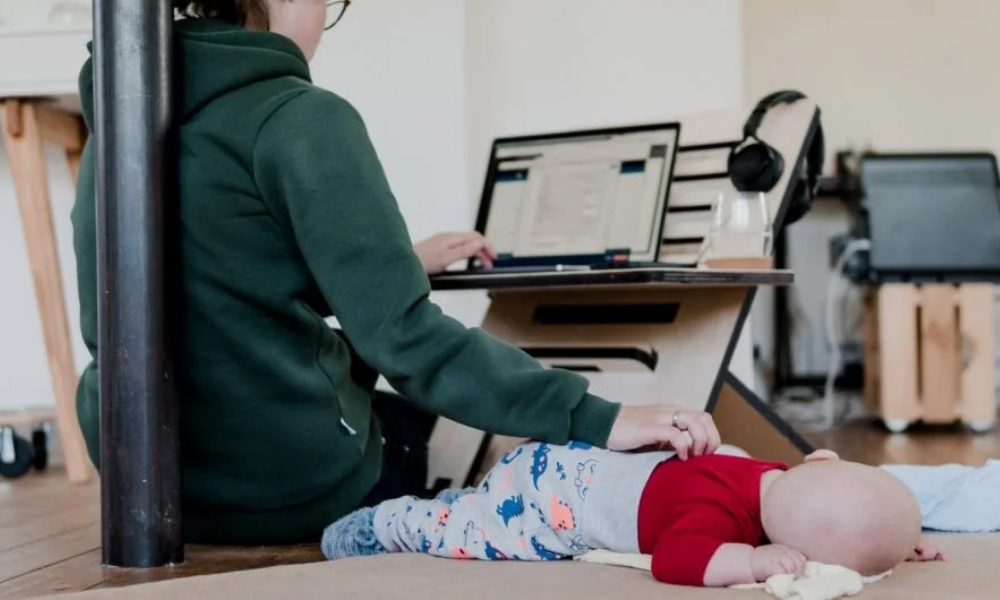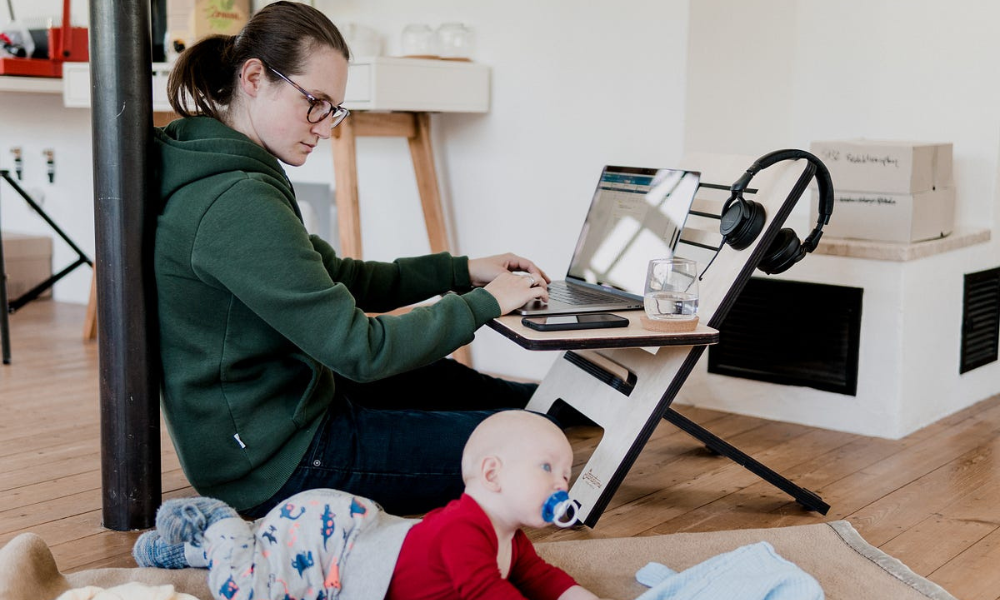How to Work from Home with a Toddler Without Losing it?
Nouman Bashir
August 3, 2025

Working from home with a toddler sounds like a dream. No daycare drop offs. No missing milestones. But most days, it feels like you are running a marathon in slippers with a toddler clinging to your leg.
One minute you’re in a Zoom call. Next, you’re cleaning crayon off the wall. If you’ve ever felt like you are failing at both parenting and productivity, you are not alone.
Balancing a toddler’s routine with remote work is tough. This guide is here to help moms who are juggling deadlines and diapers and just want to breathe without guilt.
There are ways to manage client calls and baby health. With a few smart strategies and a bit of grace, you can work from home without losing your mind.
What Are the Challenges of Working from Home with aToddler?

Working from home with a toddler sounds like a win. No commute, no daycare rush. But the reality? It’s often messy, unpredictable and mentally exhausting. Here’s why so many moms feel overwhelmed.
Constant interruptions
You sit down to start work and your toddler needs a snack, a toy or just your attention. These repeated breaks make it hard to focus. Research shows that frequent task-switching reduces productivity and builds mental fatigue over time.
Emotional pressure
You try to do it all but still feel like you’re falling short. That invisible weight of guilt builds up, leaving you drained by mid day. This emotional load often goes unnoticed but affects everything about your mood, energy and even your work performance.
No clear boundaries
Toddlers don’t get why you’re home but not fully “there.” They interrupt calls, crawl onto your lap or melt down when you can’t respond right away. It’s not misbehavior, it’s confusion. But it still disrupts your day.
Unpredictable routines
Even the best plans fall apart. One skipped nap or surprise tantrum can throw your entire workday off course. You might feel scattered and question your routines, your job or even your parenting.
Little to no help
Not everyone has a partner at home or someone to share the load. Nap time might be your only quiet window. And when that fails, you’re left juggling deadlines and toddler demands all on your own.
Naming these challenges is the first step. It’s not about fixing everything overnight, it’s about finding small ways to make the chaos feel more manageable.
Why It’s Important to Balance Work and Toddler Care

Balancing work and caring for a toddler isn’t just about surviving the day. It directly shapes your child’s development, your job performance and your emotional health. When one side takes over completely, the other suffers and so does your well being. You can manage your freelance work with your baby at home easily.
Boosts Child Development
Toddlers thrive with structure, attention and emotional connection. When parents are fully present during non-work hours, children gain better communication skills, stronger emotional regulation and more confidence.
Quality early learning and child centered routines at home can also strengthen cognitive and social development.
Improves Work Productivity
When you know your toddler is safe, engaged or resting, you can actually focus. Studies show that uninterrupted work time improves task completion, decision making and reduces mental fatigue.
Clear boundaries between parenting and work reduce the guilt and help you stay present in both roles.
Reduces Parental Stress
Trying to multitask all day answering emails while managing meltdowns leads to fast burnout. But having a balance, whether through flexible work hours, support from a partner or help from early education centers, allows you to rest, recharge and parent with more patience.
Strengthens Family Time
When you protect work hours and carve out intentional time for your toddler, your day feels more connected. You can plan storytime, walks or lunch without distraction.
Even short, focused interactions mean a lot more when they’re not interrupted by work notifications.
Encourages Healthier Routines
Balanced days often come with better routines, regular bedtimes, consistent mealtimes and smoother mornings. This helps toddlers feel secure and gives parents space to breathe.
Over time, it becomes easier to plan around your child’s natural rhythm without constantly feeling behind.
8 Tips to Manage Work from Home with a Toddler
Working from home with a toddler is not about chasing perfection. It’s about finding smart ways to manage both worlds work and parenting without burning out. These eight tips will help moms build a routine that works in real life.
1. Get Clear on When You Can Actually Work

Start by mapping your real working windows. Can you work before your toddler wakes up? During naps? After bedtime? Identify these pockets and block them on your calendar. Be realistic. If nap time is usually 90 minutes, plan for 60 and use bonus time wisely.
Once those blocks are clear, plan exactly what to do in each one. Use action words in your schedule like “Write report” or “Finish proposal.” That way, when work time starts, you already know what to tackle, no wasted minutes figuring it out.
This approach helps you feel more in control and reduces the guilt when you step away to spend time with your toddler.
2. Use the “Focus Trick” to Work from Home with a Toddler

When juggling a toddler and deadlines, shifting from “mom mode” to “work mode” can feel impossible. That’s where the focus trick helps.
Before starting work, close your eyes for two minutes. Breathe out slowly and say “one” in your mind. When you open your eyes, pick one object in front of you and focus on it. Say, “I’m ready to work.”
This quick mental reset calms your brain and helps you re-focus especially after a chaotic morning.
3. Create a Workspace Near Your Toddler

You don’t need a fancy home office. Just set up a small desk, tray table or laptop station close to your toddler’s play area. This way, you can keep an eye on them while squeezing in emails or finishing a task.
Some moms add a “work time” signal like putting on headphones or playing low focus music to help them mentally shift. It also cues your toddler that it’s quiet time even if they don’t fully understand yet.
4. Set Aside Time for Your Toddler

Toddlers crave attention. If they don’t get it, they’ll interrupt until they do. So build it in. Schedule 20 to 30 minutes of focused play before or after work blocks.
Use this time to read, build blocks or color. Let your toddler know, “This is our playtime. After this, I have work.” When they feel seen, they’re more likely to cooperate when you step away.
5. Organize a Babysitting Swap

If hiring a sitter isn’t in your budget, try a babysitting swap. Partner with a friend, neighbor or fellow parent. For example, you take the kids Monday morning while they take them Tuesday afternoon. This gives each of you a few quiet hours to work.
Even asking grandparents or older cousins for short shifts once or twice a week can be a big help. The goal isn’t full-day coverage, it’s freeing up small windows for focused work or important meetings.
6. Save Screen Time for Work Emergencies

Screen time might be something you usually limit but it can be helpful when used wisely during the workday. If you have a meeting or need quiet to focus, letting your toddler watch a show or play on a tablet for 30 to 45 minutes can give you that uninterrupted time.
Try saving screen time for emergencies or high-focus tasks. This way, it remains effective when you really need it.Choose calm, age-appropriate shows to avoid overstimulation and create a cozy setup with a snack or favourite blanket to keep your child content while you work.
7. Plan Out Fun Indoor Activities

Having activities ready keeps your toddler engaged while you work. Simple ideas include:
- Dot markers or water painting
- Car wash for toy cars
- Pouring water between cups in the bathtub
- Duplo blocks or puzzles
- A sensory bin with rice or dry pasta
These don’t need to be fancy. Just rotate them daily and save the most exciting ones for your busiest work blocks.
8. Prepare the Night Before

Take 10 minutes each evening to prepare for the next day. Review your work priorities, lay out toys or craft supplies, prep snacks and lunch and tidy your workspace.
If your partner is involved, share your schedule with them too. A shared plan means fewer surprises, better teamwork and less mental overload.
A little planning goes a long way. When the next day starts, you’ll be ready instead of reactive and that can change everything.
What Moms Should Avoid When Working from Home

Working from home with a toddler is tough enough. But some habits can make it even harder. These common mistakes often lead to stress, guilt or burnout. Knowing what to avoid can help you stay focused and create a routine that actually works.
Leaving Your Schedule to the Wind
If you wake up without a plan, the day quickly slips away. Without clear blocks for work and toddler care, you end up reacting to everything. That leads to stress and unfinished tasks.
Instead, plan your day ahead of time. Block real work windows before your toddler wakes, during nap time or after bedtime. Share your schedule with your partner if possible. A clear plan sets the tone for a calmer day.
Overestimating Your Work Hours
Trying to follow a full-time office schedule at home rarely works with a toddler around. Many parents feel like failures when they can’t work eight straight hours.
The truth is, focused work in short bursts often leads to better results. Use your best energy hours for deep work and save simple tasks for lighter moments. Be honest about how much time you really have and plan accordingly.
Mixing Work and Childcare all Day
Trying to reply to emails while playing with your toddler sounds efficient but it rarely works. You end up half-working and half parenting which feels frustrating for both you and your child.
Instead, try separating tasks. Use nap time or support from a partner for focused work. During playtime, be fully present. This helps your toddler feel seen and gives you more peace when it is time to switch roles.
Skipping Breaks and Rest
It is tempting to power through without stopping. But skipping breaks leaves you drained. Toddlers can sense your mood and react to it.
Take short, regular breaks. Step outside. Stretch. Drink water. A five-minute pause can improve your energy and your patience.
Treating Interruptions as Failure
Interruptions will happen. Your toddler might cry during a call or climb onto your lap while you are typing. That is normal, not failure.
Build buffer time into your work plan. Accept that the day may not go perfectly. A calm mindset helps you bounce back faster and stay in control even when things get messy.
Not Setting Boundaries
Toddlers do not naturally understand work time. But they can learn with gentle and clear boundaries.
You can teach them that when you wear headphones or sit in a certain chair, you are working. With consistency, toddlers adapt. Setting boundaries with your employer or partner also protects your time and energy.
Conclusion: Home with a Toddler
Working from home with a toddler is never easy. But every small effort you make and every win matters more than you think.
You are not just managing remote work. You are also raising a little human who needs your love, patience and presence. That is real work too.
Some days will feel smooth. Others might test your limits. But you are strong, capable and doing something incredibly valuable.
Whether it is scheduling nap time, saving screen time or prepping the night before, your efforts count. Keep showing up. You have got this, mama.



